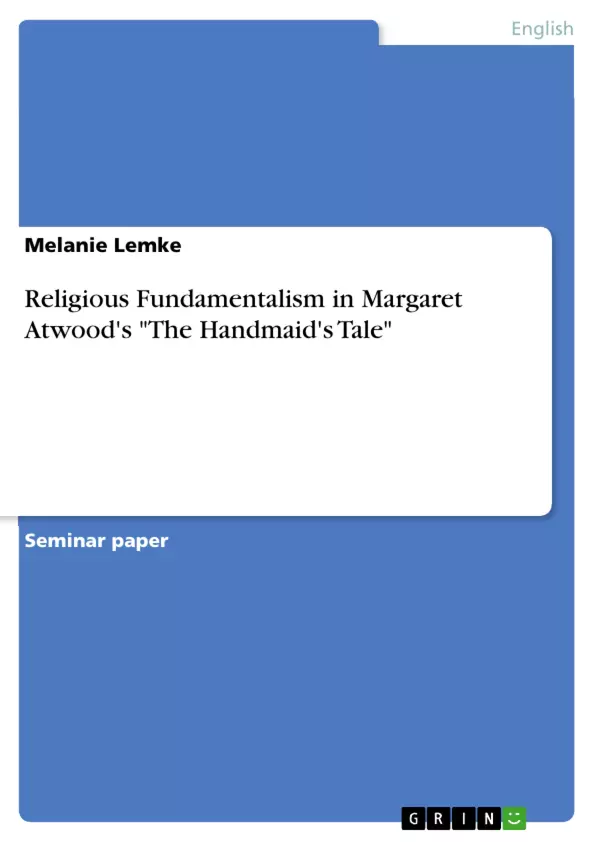Margaret Atwood needs no longer an introduction in the common sense, because she is one of the most popular and productive writers in the world. Her works, especially her novels are taught at many universities worldwide. Her books are bestsellers and subjects of critical reviews and academical studies. Margaret Atwood wrote her novel The Handmaid’s Tale in a time when religious fundamentalism had already been established in the United States. Through this historical background and her own experience with religious fundamentalism and the rising of feminism, it is not surprising that her novels also deal with such a thematic aspects. Moreover, Atwood copies her own experiences and imaginations of religious fundamentalism into the fictive and futuristic world of Gilead.
Table of Contents
- 1. Introduction
- 2. Historical Context
- 2.1. Christian Fundamentalism in the United States
- 2.2. Islamic Fundamentalism
- 2.3. Feminism
- 3. Religious Fundamentalism
- 3.1. Women in Gilead
- 3.2. Other Groups in Gilead
- 3.3. The Totalitarian Republic of Gilead
- 4. Conclusion
Objectives and Key Themes
This paper examines religious fundamentalism as depicted in Margaret Atwood's The Handmaid's Tale. It analyzes the novel within its historical context, exploring the rise of Christian and Islamic fundamentalism and the concurrent feminist movement. The study investigates how Atwood uses these historical forces to create the dystopian society of Gilead.
- The historical context of Christian and Islamic fundamentalism.
- The role of women in Gilead and the impact of religious fundamentalism on their social position.
- The persecution of minority groups within Gilead's totalitarian regime.
- The methods of control and oppression employed by the Gilead regime.
- Comparisons between Gilead and historical totalitarian regimes.
Chapter Summaries
1. Introduction: This introductory chapter establishes the context for the paper, highlighting Margaret Atwood's prominence as a writer and the relevance of religious fundamentalism as a theme in her work, particularly in The Handmaid's Tale. It outlines the paper's structure, focusing on the historical context of Christian and Islamic fundamentalism, feminism, and the central aspects of religious fundamentalism within the novel itself. The introduction prepares the reader for a comprehensive examination of how Atwood portrays religious fundamentalism in shaping the dystopian society of Gilead, comparing it with historical instances of totalitarian regimes.
2. Historical Context: This chapter delves into the historical backdrop of The Handmaid's Tale, connecting the novel to Puritan New England through references to figures like Mary Webster and Perry Miller. It explores the influence of Puritan culture and rhetoric on Gilead's societal structures. The chapter also examines the global political climate of the 1980s, characterized by fiscal restraint, social conservatism, and the widespread fear of nuclear destruction. Atwood's portrayal of Gilead as a place surrounded by toxic waste is interpreted as a reflection of environmental concerns. The chapter further highlights how religion has been used historically to justify totalitarian regimes, drawing parallels between Gilead and past dictatorships.
2.1. Christian Fundamentalism in the United States: This section traces the origins and development of Christian fundamentalism in the United States, starting from the late 19th-century religious movements and the establishment of its core principles. It discusses the influence of the Bible Conference, the emergence of the term "religious fundamentalism" in the early 20th century, and the impact of events such as the Great Depression and World War II on the movement. The section details the resurgence of fundamentalism in the mid-20th century with the rise of television evangelism and its expanding reach through various media.
Keywords
Religious fundamentalism, Margaret Atwood, The Handmaid's Tale, dystopian fiction, Gilead, totalitarianism, feminism, Christian fundamentalism, Islamic fundamentalism, historical context, social control, women's rights, oppression, Puritanism.
Margaret Atwood's *The Handmaid's Tale*: A Comprehensive Language Preview - FAQ
What is this document?
This document provides a comprehensive language preview of an academic analysis of Margaret Atwood's The Handmaid's Tale. It includes a table of contents, objectives and key themes, chapter summaries, and keywords. The information is intended for academic use, focusing on analyzing the themes of the novel in a structured and professional manner.
What are the main themes explored in the analysis of *The Handmaid's Tale*?
The analysis focuses on religious fundamentalism as depicted in the novel, examining its historical context (including the rise of Christian and Islamic fundamentalism and the feminist movement), the portrayal of women in Gilead, the persecution of minority groups, the methods of control and oppression used by the Gilead regime, and comparisons between Gilead and historical totalitarian regimes.
What topics are covered in each chapter of the analysis?
Chapter 1 (Introduction): Introduces the context of the analysis, Atwood's work, and the relevance of religious fundamentalism in The Handmaid's Tale. It outlines the paper's structure. Chapter 2 (Historical Context): Explores the historical backdrop of the novel, connecting it to Puritan New England, the global political climate of the 1980s, and the historical use of religion to justify totalitarian regimes. Chapter 2.1 (Christian Fundamentalism in the United States): Traces the origins and development of Christian fundamentalism in the US. Chapter 3 (Religious Fundamentalism): Analyzes religious fundamentalism within the novel, focusing on the roles of women and other groups in Gilead, and the nature of Gilead as a totalitarian republic. Chapter 4 (Conclusion): [Content not detailed in preview].
What is the overall objective of this academic analysis?
The analysis aims to examine how Margaret Atwood uses historical forces (Christian and Islamic fundamentalism and feminism) to create the dystopian society of Gilead in The Handmaid's Tale.
What are some key words associated with this analysis?
Religious fundamentalism, Margaret Atwood, The Handmaid's Tale, dystopian fiction, Gilead, totalitarianism, feminism, Christian fundamentalism, Islamic fundamentalism, historical context, social control, women's rights, oppression, Puritanism.
What is the intended audience for this document?
This document is intended for academic use, supporting structured and professional thematic analysis.
- Arbeit zitieren
- Melanie Lemke (Autor:in), 2008, Religious Fundamentalism in Margaret Atwood's "The Handmaid's Tale", München, GRIN Verlag, https://www.hausarbeiten.de/document/122479


